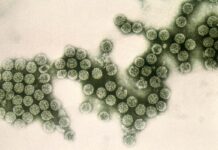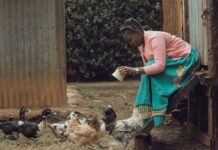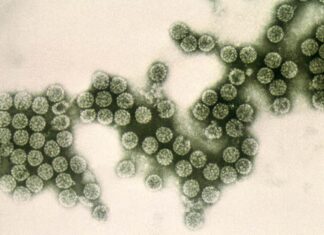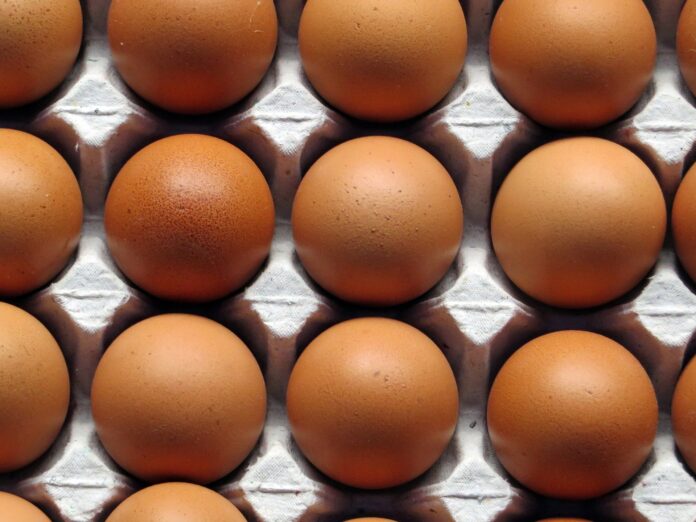
Canada occupies a unique position among egg-producing countries because, since the 1970s, it has adopted a management system that ensures the supply of high-quality food to its population while guaranteeing positive operating results for all farms and companies involved in the supply chain. Despite criticism of the system, particularly from the United States, Canada has maintained it. The aim of this article is to introduce the supply management system and to demonstrate its application using the development of egg production between 2019 and 2023 as an example.
Supply management – What is it?
Supply management was introduced in the 1970s. It controls the quantity and price of a range of food products. It was prompted by the volatility of milk prices in the 1960s, which caused major economic problems for dairy farmers. They approached the government and asked it to take steps to regulate production levels, market prices and imports in a way that would allow profitable production. After weighing up the pros and cons, the legal basis for the system was created in 1972 in the Agricultural Products Agencies Act. The federal government’s Agriculture and Agri-Food Canada oversees the Canadian Dairy Commission and the Farm Products Council of Canada. The latter is responsible for eggs, chicken and turkey meat. The national marketing board Egg Farmers of Canada was established in 1972, and similar boards for chicken and turkey meat and hatching eggs were established in subsequent years. The aim of the supply management system is to ensure the quality and safety of the products produced and to ensure a positive operating result for all elements involved in the supply chain (Muirhead 2016). Soon after its introduction, the system was criticised for making it difficult for foreign producers to enter the market. As the production quotas allocated to farms ensured a full supply, imports were not necessary. Complaints to the OECD against the system were unsuccessful, as was President Trump’s attempt to exclude it from NAFTA renegotiations during his first term. Even in the new agreement (USMCA), Canada retains the right to apply the supply management system. In 2024, 1,270 laying hen farms were connected to the system.
Number of laying hens and egg production continue to rise
The number of laying hens in Canada increased from 33.5 million to 35.6 million, or by 6.2%, between 2019 and 2023. At the same time, egg production increased by 7.5% (Table 1). The higher rate of growth in egg production was a result of improved average laying performance of hens. The relative increase between 2021 and 2022 was higher than in the other years. This reflects the increased demand for eggs during the Covid-19 pandemic. Eating out decreased because restaurants were closed, and home cooking increased.
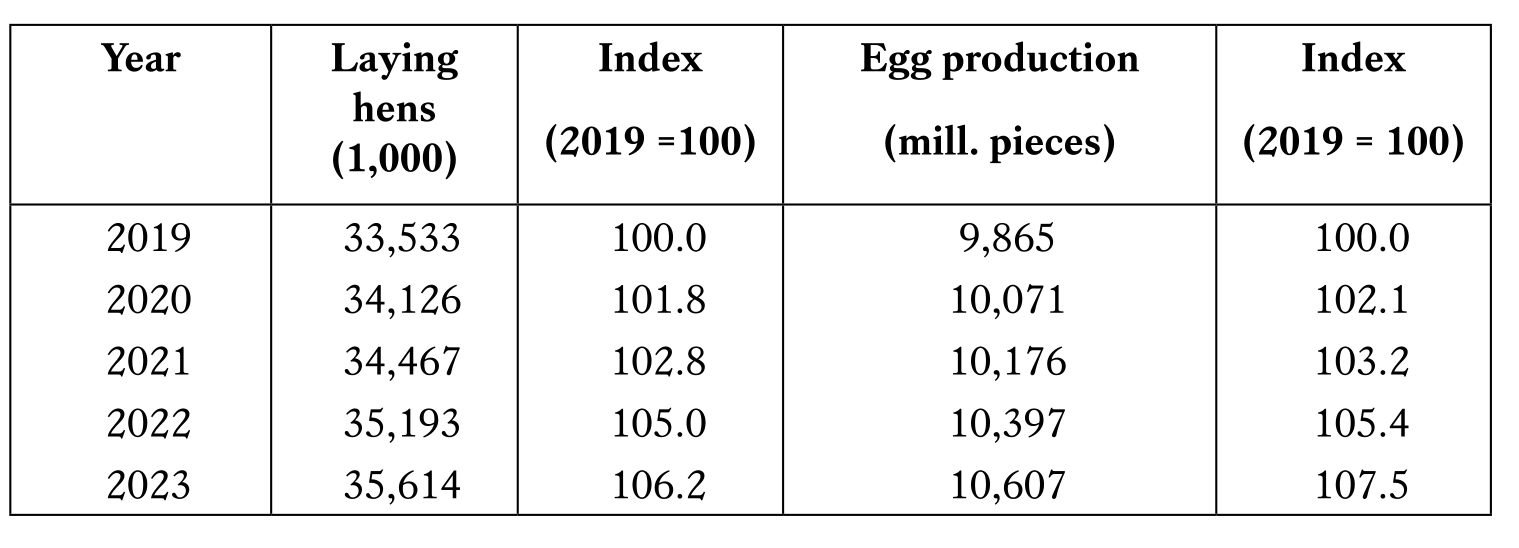
Large differences in average flock sizes
Table 2 shows that the number of farms connected to the supply management system is very unevenly distributed across the individual provinces. The spatial pattern reflects the population size, population density and location in relation to urban agglomerations, as well as the availability of raw materials for feed production.
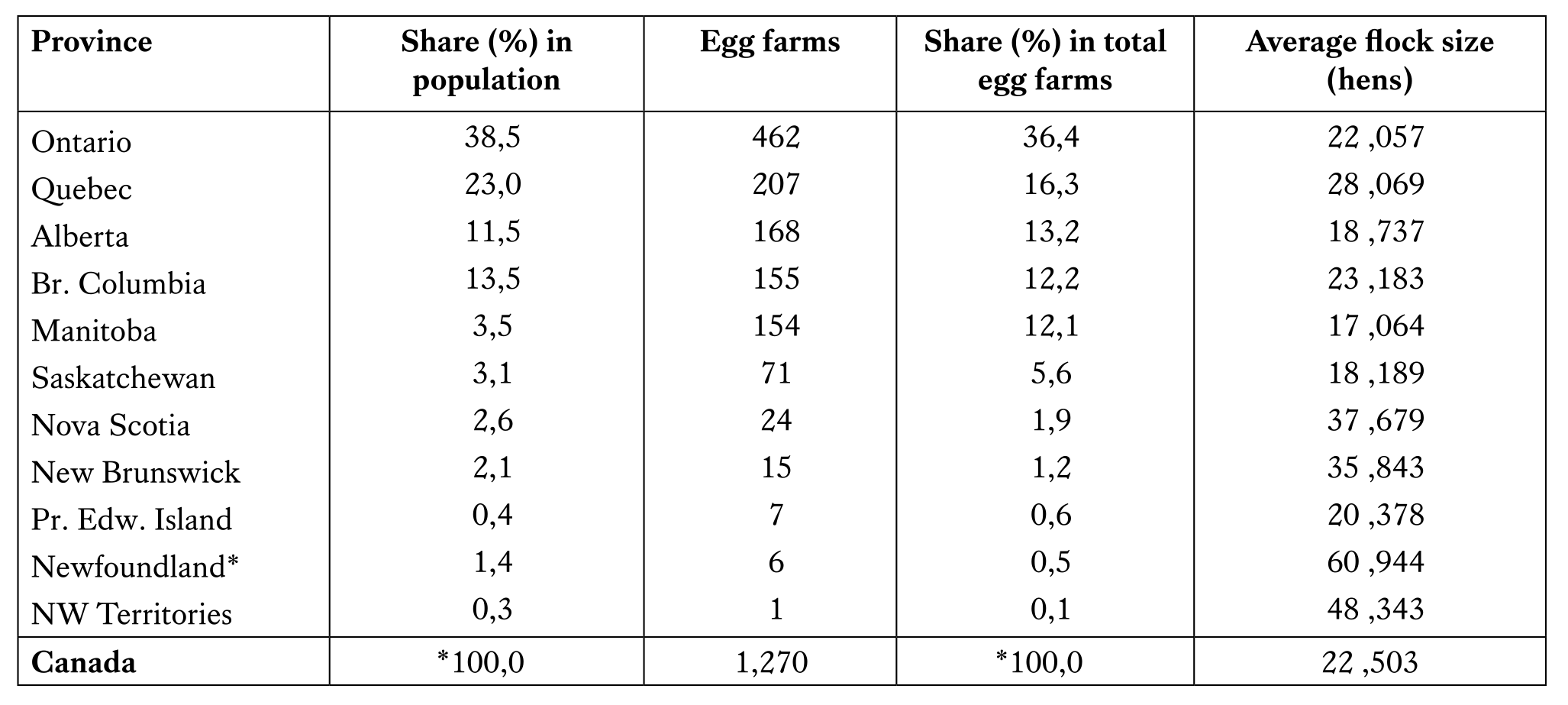
* and Labrador
** sum does not add because of rounding
The differences in average flock sizes are striking. Farms in Newfoundland and Labrador and the Northwest Territories have the highest values, followed by farms in Nova Scotia and New Brunswick, which are located on the outskirts of urban areas. Here, too, farm sizes are well above the national average. In terms of production, they are geared to supplying the population of the province and the major cities of Quebec, including Montreal. The central provinces of Manitoba and Saskatchewan have the smallest farm sizes. The provinces of Alberta and British Columbia are more balanced in terms of population and egg-producing farms. Alberta’s farm size is similar to that of the eastern plains, while British Columbia’s is slightly above the national average.
Figure 1 compares the provincial shares of the number of egg-producing farms and laying hen flocks. Ontario and Quebec accounted for 51.4% of the farms and 58.5% of the flocks in 2023. In contrast, the three Atlantic provinces of Nova Scotia, New Brunswick and Newfoundland and Labrador accounted for only 3.7% of the farms but 6.6% of the laying hens, a consequence of their larger laying hen flocks.

Production quotas and egg production
The Farm Products Council of Canada sets the permissible production quotas for the provinces for the following year. The provinces then allocate the quotas to individual farms. The price the farmer receives for each egg delivered is based on the allocated production quota. If the quota is exceeded, the extra eggs must be sold at the prevailing market price. This is usually unattractive, so farmers try not to exceed their quota. However, if there is a shortage in the market supply, e.g. due to an outbreak of avian influenza, it may be attractive to supply eggs to the world market. Table 3 shows that six provinces exceeded their allocated quota, while the others produced less than allowed. In terms of quantity, farmers in Ontario exceeded their quota by 687 million eggs. The highest relative overrun was in New Brunswick at 138.8%. The provincial share of the permitted production quota and egg production is shown in Figure 2. These quotas can be exceeded if special market situations make this necessary. For example, the massive outbreaks of avian influenza in 2023 led to supply shortages. By October 2023, the highly pathogenic virus had appeared on 319 farms. A total of 7.8 million birds fell victim to the disease or were culled as a precautionary measure. Farms were able to use the additional quota of 480 million eggs allowed for such situations. In addition, eggs and egg products were imported from the USA to ensure supply to the population.
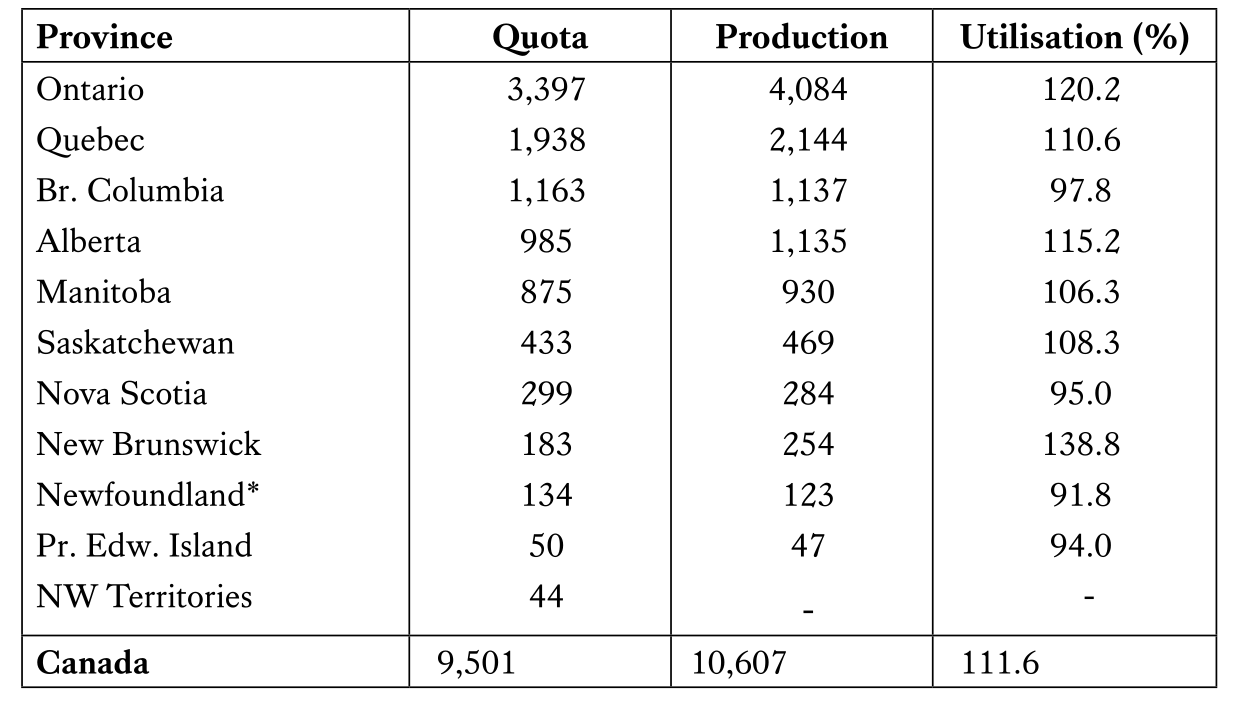
* and Labrador

Challenges and perspectives
In addition to the ongoing threat of the highly pathogenic avian influenza virus to laying hen flocks, the Canadian egg industry faces other challenges. These include changes in the way laying hens are reared and demands for more sustainable production, as well as continued criticism of the supply management system.
The Canadian layer sector is in the process of changing its housing systems. Table 4 shows that between 2019 and 2024 conventional cage housing sharply declined and only 43.3% of hens were still housed in such systems. Small aviaries1 had a share of 36.9%. However, this means that 80.2% will still be kept in these controversial housing systems. Floor housing (free-run system), which is dominant in the EU, is less important in Canada with 13.5%. The same applies to the free-range system, which is unlikely to increase in the future due to the threat of the introduction of the avian influenza virus via wild birds. Organic farming is stable at around 4.8-5.2%.

The first outbreak of the highly pathogenic avian influenza occurred in Nova Scotia in January 2002. In the following months, laying hen flocks were infected in all provinces. Massive losses were recorded in British Columbia, Alberta and Manitoba. In the following years, the highest losses occurred mainly in British Columbia and the Prairie Provinces. It is noteworthy that only a few further outbreaks occurred in the Atlantic provinces. There is a close correlation between the flyways of migratory wild birds and infections in poultry flocks. The Pacific flyway has been particularly frequented in recent years (Table 5). The cyclical nature of the outbreaks is also evident (Figure 3). There is a parallel with AI infections in the USA (Windhorst 2023, 2024).
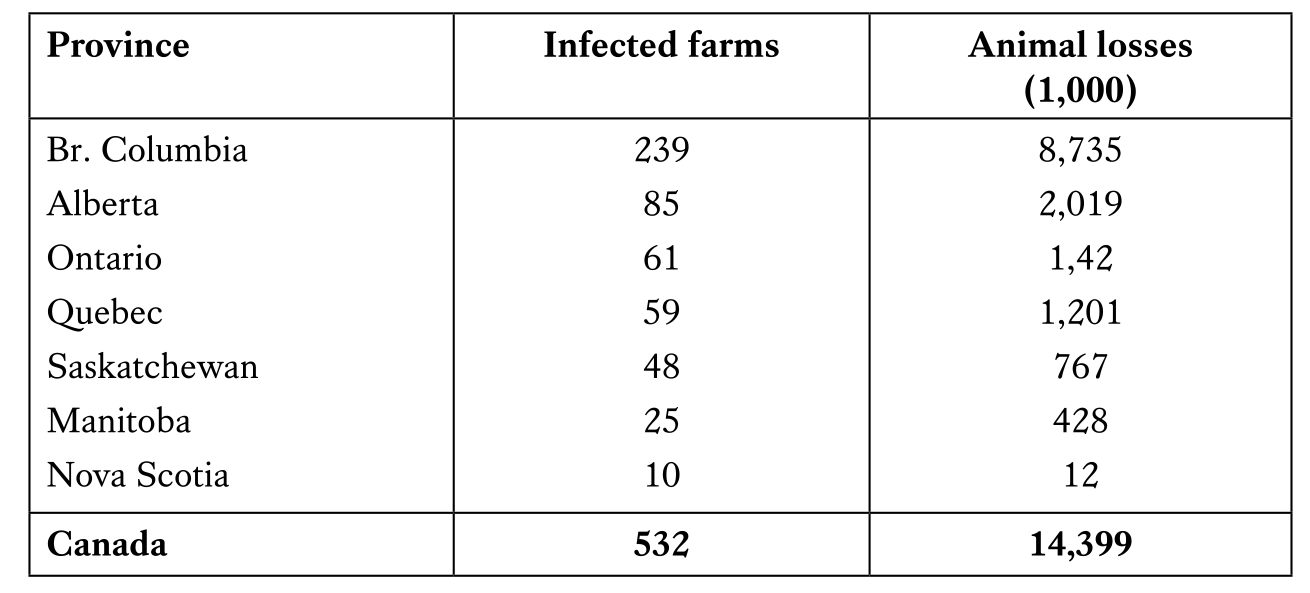
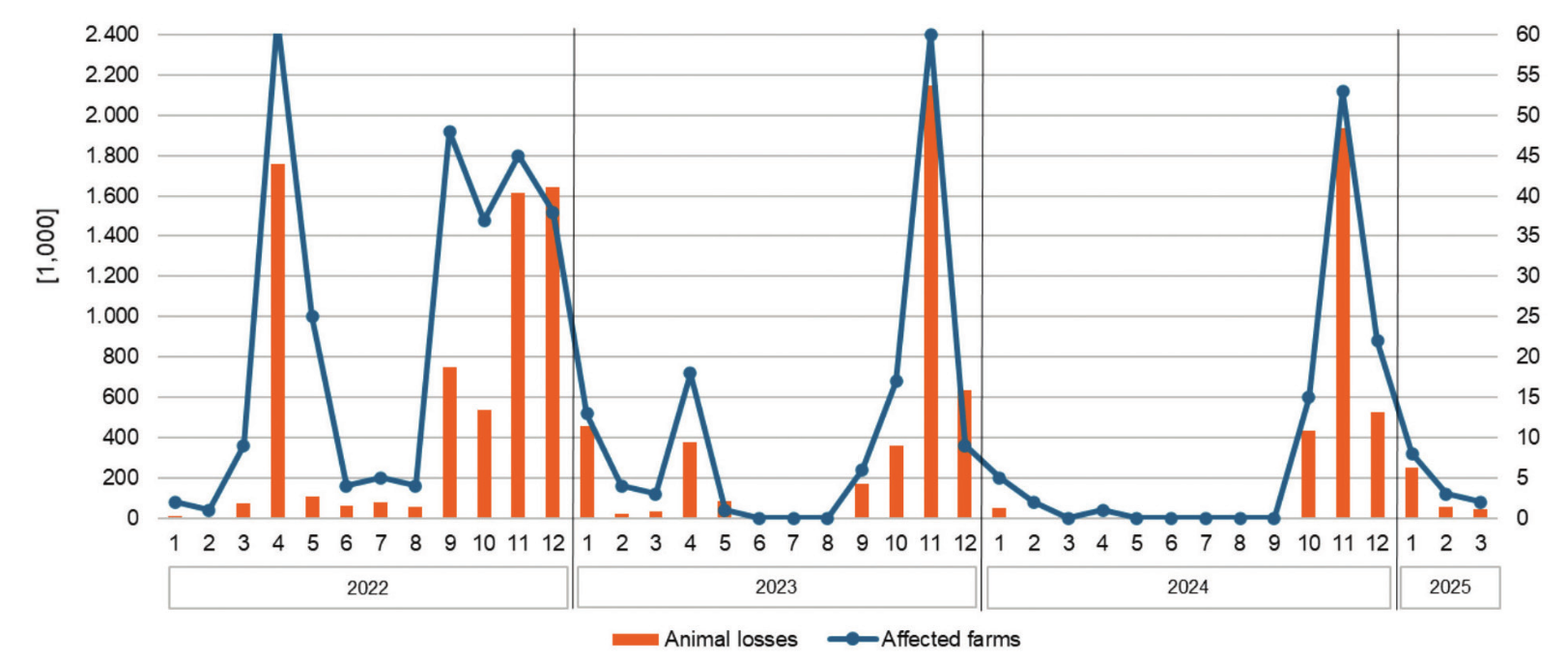
January 2022 and March 2025 (design: A.S. Kauer based on Egg Farmers of Canada, Annual Report 2023)
The high economic losses in 2022, 2023 and at the end of 2024 have fueled the debate on preventive vaccination against the virus. Because Canada is not a major exporter of poultry meat, unlike the US, vaccination could be more easily implemented. In the USA, preventive vaccination has so far failed due to opposition from leading slaughterhouses, as it could lead to a massive drop in exports.
Another challenge is adapting the supply management system to population growth. Between 2019 and 2023, the population rose from 37.2 million to 38.8 million. A further increase to 39.6 million is forecast by 2025. The population is growing by around 400,000 people per year. Of this, 140,000 is due to natural population growth and 260,000 to immigration. Demand is therefore increasing by around 100 million eggs per year. It could increase even further if per capita consumption were to increase further. This development must be taken into account by adjusting the production quota and its distribution among the individual provinces. An annual increase of 335,000 hens with an average laying rate of 298 eggs per hen per year will be necessary. Table 6 shows the changed quota allocation for 2024 and 2025 compared to 2023. The quota allowed in 2025 will increase by 1.67 billion eggs, or 17.6%, compared to 2023 to meet the expected market demand. Ontario and Quebec will account for half of this increase. The relative change across provinces will vary considerably. The highest growth rate is estimated for Alberta at 22.5% and the lowest for Newfoundland and Labrador at 4.5%.
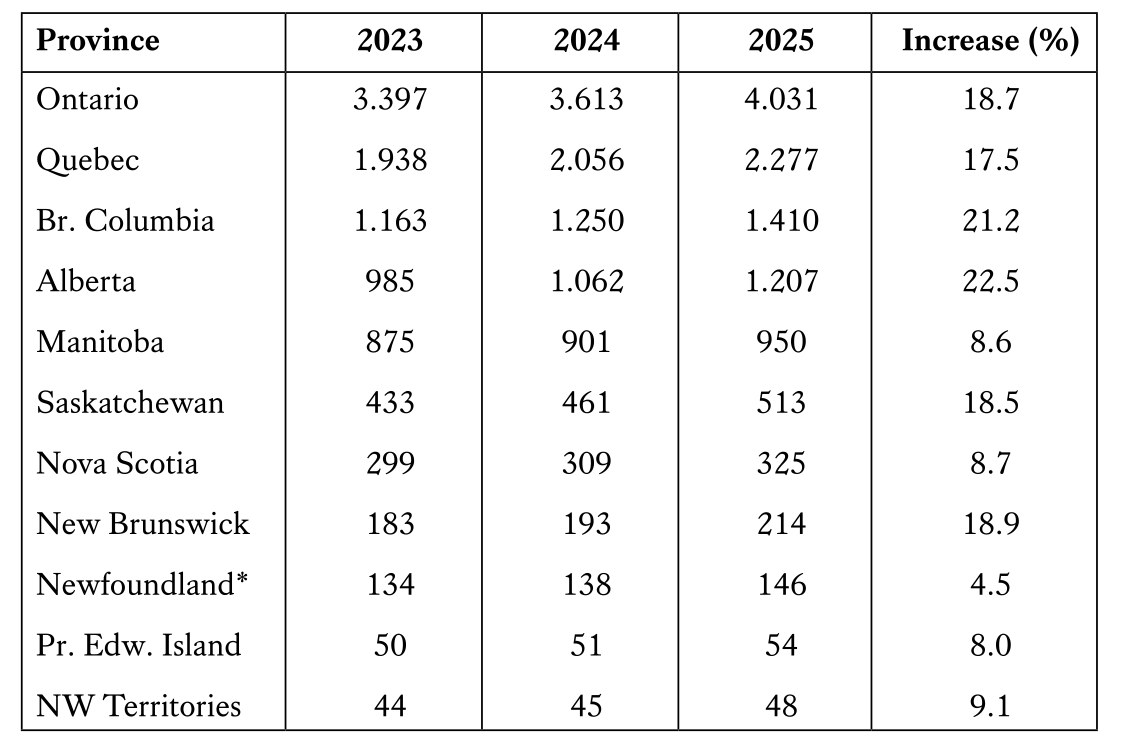
Egg Farmers of Canada launched an initiative in 2024 to help improve the conditions in which laying hens are kept by amending the Code of Practice for the Care and Handling of Pullets and Laying Hens to reflect new scientific knowledge. It also aims to reduce the environmental impact of laying hen production and achieve net-zero greenhouse gas emissions by 2050.
A step to protect the supply management system through legislation that would prohibit the government from entering into trade agreements that allow an increase in the tariff rate quota for egg imports or reduce tariffs on eggs imported in excess of the current tariff rate quota was taken in 2022. The bill was introduced in the House of Commons in June 2022 and passed in June 2023. The Senate has debated the bill but has not yet taken a decision. Passage of the bill would be significant not only for the poultry industry, but also for dairy farmers and milk production. Critics, however, argue that such market fragmentation may not be in the best interests of consumers because it would reduce or even eliminate competition. Overall, however, about 90% of Canadians support the supply management system because it ensures high-quality domestic products and stable market prices.
Data sources and supplementary literature
Canadian Food Inspection Agency: Status of ongoing avian influenza response by province. https://inspection.canada.ca/en/animal-health/terrestrial-animals/diseases/reportable/avian-influenza/latest-bird-flu-situation/status-ongoing-response. (Accessed: July 30th 2025)
Egg Farmers of Canada (Ed.): Annual Report 2023. https://www.eggfarmers.ca/resource/annual-reports. (Accessed: 25. 3. 2025).
Egg Farmers of Canada (Ed.): Annual Report 2024. https://www.eggfarmers.ca/wp-content/uploads/2025/03/2025-03-19_Egg-Farmers-of-Canada_Annual-Report-2024.pdf. (Accessed: 31. 3. 2025).
Muirhead, B.: Under Siege: Supply Management as Threatened Paradigm. Ottawa 2016. www.nfu.ca/sites/www.nfu.ca/files/Muirhead.pdf. (Accessed: 30. 3. 2025).
Statistics Canada: Production and Disposition of Eggs, Annual. https://www150.statcan.gc.ca/t1/tbl1/en/tv.action?pid=321001190. (Accessed: 25. 5. 2025).
The Regulatory Research Institute of Canada (RRI) (Ed.): Egg Market Gets New 2025 Federal Limits. https://rricanada.org/2025/01/16/egg-market-gets-new-2025-federal-limits. (Accessed: 27. 3. 2025).
Wikipedia: Dairy and Poultry Supply Management in Canada. https://en.wikipedia.org/wiki/Dairy_and_poultry_supply_management_in_Canada.(Accessed: 25. 3. 2025).
Windhorst, H.-W.: Two waves, different routes and changing dynamics. The Avian Influenza outbreaks in the USA in 2022. In: Poultry World 39 (2023), no. 2, p. 8-11.
Windhorst, H.-W.: Third Avian Influenza outbreak in the USA within 10 years: the 2023-2024 epidemic. In: Zootecnica International 46 (2024), no. 9, p. 28-33.


